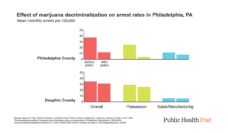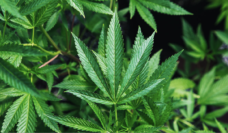Beginning in 2012, several states began legalizing the commercial sale of marijuana. Publicly available state-level data, reports, and investigatory findings, peer-reviewed studies, and government health surveys from over the last eight years show how these marijuana policy changes — and the industry they created — affect families and communities. Given that Colorado has had a marijuana market in place, and state-mandated data collection across many metrics, it provides us with the best look at how legalization affects a population.
In “legal” states, marijuana stores outnumber popular food chains. For example, in Colorado, marijuana retail locations outnumber all McDonald’s and Starbucks locations in the state combined. Such numbers promote and normalize marijuana use.
Furthermore, the marijuana products found in such states are far removed from the 5% THC “Woodstock weed” of yesteryear. Today, the average THC potency in marijuana flower averages at least 17%, while concentrates and edible products can contain upward of 95-99% THC. The demand for these super-strength versions of the drug is dangerous, as high potency marijuana exacerbates harmful health consequences. According to recent research, frequent users of such products are five times more likely to develop schizophrenia and psychosis.
Thousands of peer-reviewed articles link marijuana use to severe mental health outcomes, ranging from depression to psychosis, consequences for physical health, and inhibited cognitive development. Such connections are often lost in conversations on legalization.
Marijuana commercialization has led to a marked increase in emergency room visits and accidental exposures in children. In Colorado, the number of marijuana-related emergency department visits rose 54% and yearly marijuana-related hospitalizations increased 101% from 2013-2017. Between 2013 and 2018, instances of marijuana-related exposures in children age 8 or younger increased 126%. In 2018, such cases represented over half of all marijuana-related exposure calls.
Speaking of kids, rates of use and acceptance of marijuana among youth are rising in “legal” states. In Colorado, marijuana has increased since 2017 among all age groups and grades. In the under 15 group, the increase was nearly 15%. Furthermore, there has been a nearly five-fold increase in youths “dabbing” and a doubling of vaping high potency THC since 2017.
Lawmakers and the public need data on the consequences of legalization and related costs. Meanwhile, we should pause future legalization efforts and implement public health measures such as potency caps in “legal” states.
Legalization advocates claim marijuana reform is an integral part of social justice efforts, but the data show this to be false.
While arrests for marijuana offenses have generally fallen in Colorado, African Americans are still more than twice as likely to be arrested for marijuana offenses as whites. Furthermore, law enforcement contacts with young people of color in Colorado remain high. During the 2016–2017 school year, 23% of all law enforcement contacts with Hispanic youth and 15% of all law enforcement contacts with African American youth were related to marijuana. The industry routinely places its stores disproportionately in communities of color.
The underground market continues to explode. A 2019 audit by Oregon’s Secretary of State found that the volume of marijuana produced there is nearly 7 times its local consumption and just 30% of the state’s market is legal. As the US Attorney in Oregon reported in 2018, the state has “an identifiable and formidable marijuana overproduction and diversion problem”.
The proliferation of illicit marijuana bolsters the activity of international cartels, which extend as far north as Alaska. In California, authorities suspect that illegal marijuana activity is tied to the Sinaloa and La Familia Michoacana cartels.
The Drug Enforcement Administration concluded in their recent National Drug Threat Assessment: “Domestic production and trafficking of marijuana will likely increase as more states adopt or change current marijuana laws to establish medical or recreational marijuana markets, allowing criminals to exploit state legality”.
Lawmakers and the public need data on the consequences of legalization and related costs. Meanwhile, we should pause future legalization efforts and implement public health measures such as potency caps in “legal” states. In addition, the industry’s influence on policy should be significantly curtailed.
Photo via Getty Images














